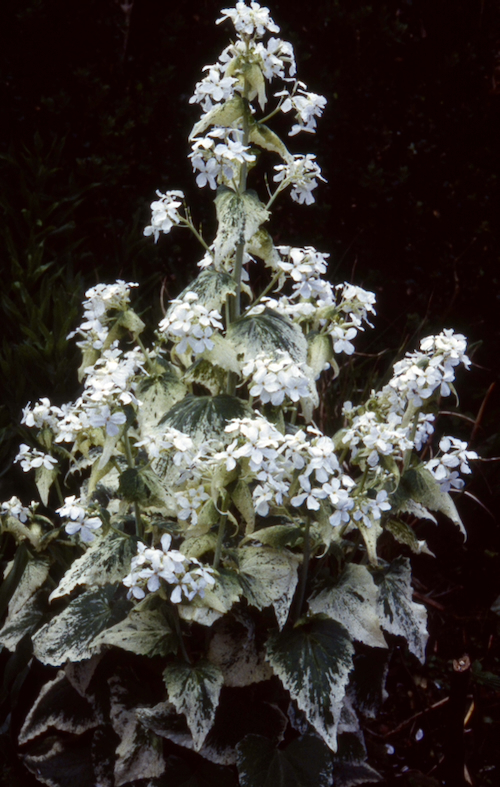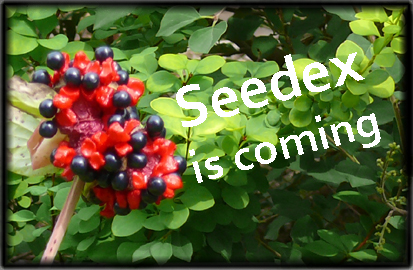
Plant of the Month December 2024
GENERAL INFORMATION: These are long-lived perennials, planted more frequently in the past. One was in our garden when we moved in in 1973, probably planted about 1950. I did not know what it was and killed it by moving at the wrong time and by planting too deep.
Synonym: Paeonia hybrida, Paeonia carthalinica, Paeonia tenuifolia subsp. biebersteiniana.
Common Name: Fern leaf peony, steppe peony, narrow-leaved peony, fennel-leaved peony.

Paeonia tenuifolia, double.

Paeonia tenuifolia ‘Rosea'.
Cultivars: have single or double flowers, in pinks or reds. Leaves vary a little in their division. Some leaves are red flushed. Paeonia tenuifolia var. plena - double red, ‘Little Odin', - small, darker red, ‘Itoba’ - single pinkish red, Paeonia tenuifolia ‘Rosea', ’The Fawn’ pink double, Paeonia tenuifolia ‘Rosea Plena’, also double pink.
Life Cycle: Herbaceous perennial.
Height and width: 0.5 - 1m.
Bloom Time: Mid May in Toronto.

Paeonia tenuifolia, flower.
Flower Colour & Size: Cup-shaped crimson-red flowers, about 10 cm across. Numerous central yellow stamens.
Leaves: are alternate, compound, divided into narrow needle like leaflets, giving the plant a ferny or lacy appearance. Red flushed when young.

Paeonia tenuifolia, leaves.

Paeonia tenuifolia, early leaves.
Fruit: 2 or 3 hairy follicles, about 2 cm long. Black seeds, approx. 3x5 mm in size.

Paeonia tenuifolia, follicles.
Range: Native to Eastern Europe, the Caucasus Mountains, southern Russia and Kazakhstan.
Habitat: Grasslands, scrubland.
CULTIVATION:
Plant: with crown no more than 5 cm below surface.
Light: Part shade to full sun.
Soil: Most soils, humus rich, deep and well drained.
Water: Average, moist.
USDA Hardiness: Zones 3-9. Needs winter cold.
Fertilizer: Balanced fertilizer or compost when leaves start to grow.
Companion planting: Other rock garden plants., border perennials.

Paeonia tenuifolia in Rock Garden.
Propagation: Divide large clumps very carefully in early fall. From seed - Sow at 4°C for 3 months, then place @ 20°C for 3 months. It doesn't need a warm period first; radicle appears after cold/moist stratification.
Pest and Diseases: Usually disease resistant but may get phytophthora blight or botrytis blight in wet conditions or poorly drained soil. Remove old leaves in fall.
Native Alternatives: Paeonia brownii and Paeonia californica are not showy and are native to western North America. They are very difficult to grow.
Pollinators: Bees and butterflies on single flowered plants.
References:
https://www.rhs.org.uk/plants/12184/paeonia-tenuifolia/details
https://www.missouribotanicalgarden.org/PlantFinder
https://onrockgarden.com/index.php/germination-guide
Text and images supplied by Anna Leggatt (Toronto Master Gardener)

Plant of the Month November 2024
GENERAL INFORMATION: November brings many seed lists for us to peruse and to select desirable offerings. I was intrigued by the description of Ipomopsis rubra many years ago. Would it be hardly? A Texan plant? It has self-seeded nearly every year, only deterred by shade and a wet March. The fist-sized rosettes are attractive additions to the rock garden during the first year. Tall flowering spikes attract many pollinators, especially hummingbirds.
Synonym: Gilia rubra.
Common Name: Standing cypress, scarlet gilia, Texas plume and flame flower.
Variants: Yellow flowered form.
Life Cycle: Herbaceous biennial. May last to another season in the south if dead-headed.
Height: To 150 cm high, 30 cm wide, in 2nd year.

Ipomopsis rubra in Rock Garden.
Leaves: Mid-green compound pinnate leaves up to 2.5 cm long, with very narrow leaflets. Forms a ferny fist-sized rosette the first year. The 2nd year flowering stalk is leafy.

Ipomopsis rubra -Seedlings showing leaf structure.
Bloom Time: July - September.
Flower Colour & Size: A thick spike of many scarlet tubular flowers, 2 cm long, opening to a 5-petaled star. The centre is whitish, dotted with red.

Fruit: 2- partitioned capsule containing black seeds.

Ipomopsis rubra - flowers

Ipomopsis rubra - capsules.
Range: Native to SE USA.
Habitat: Dry, sandy or rocky fields or open woodland.
CULTIVATION:
Plant: Scatter seeds in situ in fall or start indoors. Their height requires careful siting.
Light: Full sun, will not grow as well in light shade.
Soil: Most soils.
Water: Dry to medium moisture. Must be well drained.
USDA Hardiness: Zones 5-9.
Companion planting: Other rock garden plants.
Propagation: Self seeds in garden. Indoors from seed: Sow @ 20°C. Seed germinates within 3 months. Dislikes transplanting.

Ipomopsis rubra - seedlings.
Pest and Diseases: Nothing serious.
Pollinators: Hummingbirds.
References:
https://plants.ces.ncsu.edu/plants/ipomopsis-rubra/
https://www.gardenia.net/plant/ipomopsis-rubra
https://onrockgarden.com/index.php/germination-guide/germination-guide
Text and images supplied by Anna Leggatt (Toronto Master Gardener)

Plant of the Month October 2024
GENERAL INFORMATION: Now is the time to plant bulbs for next spring’s display. Small bulbs should be planted by now. Daffodils, Tulips and Lilies may be planted in the next few weeks. Narcissus poeticus is a favourite, one of the first Daffodils in cultivation. It was known in ancient Greece and may be the flower associated with the Narcissus legend. It is classified as a small cup Narcissus. Daffodils have a central trumpet, longer than the surrounding tepals.

Narcissus poeticus.
Common Name: Poet's daffodil, poet's narcissus, nargis, pheasant's eye, findern flower, pinkster lily,
Cultivars: Narcissus poeticus var. recurvus, - reflexed petals; Narcissus poeticus 'Praecox'; Narcissus ‘Actaea’ - larger flowers, Narcissus 'Double Poets’ (1601)
Life Cycle: Perennial bulb.
Height: 30 - 60 cm.
Bloom Time: Late spring - early May in Toronto.

Narcissus poeticus -flower.
Flower Colour & Size: Flat flower about 7cm across, with 6 pure white tepals. Small, central yellow cup (corona) with a red rim and green throat.

Narcissus poeticus - leaves and flowers.
Scent: Very fragrant. Narcissus oil is used in 11% of perfumes.
Leaves: Narrow mid green leaves, strap-shaped, to 30-40 cm long.
Range: Native to Central and Southern Europe.
Habitat: Alpine and sub-alpine meadows, woodland edges.
CULTIVATION:
Plant: bulbs in groups in the fall, 8 cm apart, 18 cm deep.
Light: full sun, partial shade.
Soil: All soils. Not strongly acidic or alkaline.
Water: Well drained, but moist in growing season. Do not let bulbs get hot and very dry while dormant.
USDA Hardiness: Zones 3-9. Needs winter cold.

Narcissus poeticus - with late spring flowers.
Companion planting: Among grasses, next to deciduous trees and shrubs, with other bulbs and spring flowers. Long lasting. Plants have been in our garden for over 50 years.
Propagation: From seed - Expose to fluctuating winter temperatures including freezing for 3 months. Gradually increase light and temperature in the spring. Keep seedlings cool; need winter protection. Division of bulbs after leaves died down.
Toxicity: If eaten, it is a strong emetic and irritant. Can irritate the skin. The scent can give a person a headache and vomiting if a large quantity is kept in a closed room.
Pest and Diseases: Usually pest free. Aphids, spider mites, and mealybugs can occur, especially with overwatering. Also Narcissus bulb fly. Remove dying leaves and rotting bulbs.
Native Alternatives: Camassia.
Pollinators: Bees.
References:
https://www.gardenia.net/plant/narcissus-poeticus-var-recurvus-poeticus-daffodil
https://en.wikipedia.org/wiki/Narcissus_poeticus
https://onrockgarden.com/index.php/germination-guide
Text and images supplied by Anna Leggatt (Toronto Master Gardener)

Plant of the Month September 2024
GENERAL INFORMATION: An attractive small variegated dogwood, Found as a sport on a shrub in Maryland in 1988. Registered in 1993.
Common Name: Wolf Eyes dogwood.
Synonym: Benthamidia japonica 'Wolf Eyes’.

Cornus kousa 'Wolf Eyes'.
Life Cycle: Small, slow growing, broad-leaved deciduous tree.
Height: Up to 15 m, with spreading branches.
Bloom Time: June in Toronto.

Cornus kousa 'Wolf Eyes' in June.
Flower Colour & Size: Four creamy white petal-like bracts surround a central clump of tiny greenish flowers. Size - about 8 cm across.

Cornus kousa 'Wolf Eyes' inflorescence and pollinator.
Fruit: Red, compound edible berry about 2-5 cm across. Very attractive to wildlife.

Cornus kousa 'Wolf Eyes' fruit and start to fall colour.
Leaves: Narrow, pointed, gray-green wavy leaves with a distinct white margin. Fall colour is a pinkish red.

Cornus kousa 'Wolf Eyes' leaves.
Range: Cornus kousa is native to East Asia.
Habitat: Shaded woodlands on slopes.
CULTIVATION:
Light: Part Shade.
Soil: Preferably acid to neutral soil with plenty of humus.
Water: Moist soil, not waterlogged.
USDA Hardiness: Zone 5.
Companion planting: Other shrubs or use as a specimen tree.

Cornus kousa 'Wolf Eyes' with companion shrubs.
Propagation: Try cuttings or layering. From seed - Use repeated cycles of 4°C, then 20°C for 3 months each. Germination is very prolonged. Pulpy coat inhibits germination. Remove by soaking and rinsing in clean water for approximately 7 days. Discard water. May not come true from seed but plants are self fertile.
Pollinators: Bees and flies.
Pests: generally pest free.
Native Alternatives: Cornus alternifolia, Cornus alternifolia ‘Argentea’.
References:
https://landscapeplants.oregonstate.edu/plants/cornus-kousa-wolf-eyes
https://onrockgarden.com/index.php/germination-guide
Text and images supplied by Anna Leggatt (Toronto Master Gardener)

Plant of the Month August 2024
GENERAL INFORMATION: I fell in love when I saw this outstanding sedum with eye-catching foliage. It was 2019 Plant of the Year at Chelsea Flower Show. Sun, well-drained soil, low moisture, ground cover or specimen plant, attracting pollinators. What else can you ask for?
Scientific name: Sedum takesimense ‘Atlantis' ('Nonsitnal' PP27454)
Common Name: Takeshima Stonecrop.
Range: Native to coastal Korea, growing among rocks by the sea.
Life Cycle: Clumping, succulent perennial, dying down in winter. New growth pink flushed.

Sedum takesimense ‘Atlantis' in February with new growth and old stems.
Height: to 15 cm high, 30 cm wide.
Leaves: Variegated, smooth fleshy dark green leaves with wide, creamy yellow serrated margins, to 4 cm long and 1.5 cm wide. Pink flushed in cold.

Sedum takesimense ‘Atlantis' - leaves.
Bloom Time: July to early fall in Toronto.

Sedum takesimense ‘Atlantis' - young plant.
Flower Colour & Size: Clusters of small, 1 cm across, yellow star-like flowers with 5 petals, 10 stamens with dark anthers and 5 large central carpels.

Sedum takesimense ‘Atlantis' - flowers.
CULTIVATION:
Plant: In rock garden, on banks or in planters. Remove any all-yellow and old stems.

Sedum takesimense ‘Atlantis' - with yellow leaves.
Light: Sun - at least 6 hours for best colour contrast. Light shade if hot.
Soil: Poor to average soils, very well drained. Some humus.
Water: Minimum water. Hates excess moisture.
USDA Hardiness: Zones 4-9.
Companion planting: Other rock garden plants.
Propagation: Stem cuttings or division.
Pollinators: Bees, butterflies, hummingbirds.
Pests & Diseases: Possibly aphids.
References:
https://www.waltersgardens.com/variety.php?ID=SEDAT
Text and images supplied by Anna Leggatt (Toronto Master Gardener)



